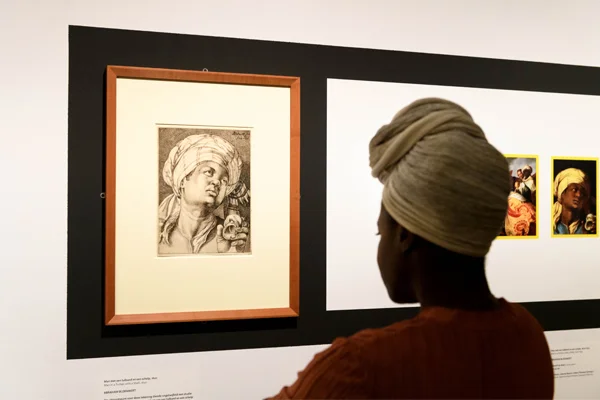Black people were present in the Netherlands in the seventeenth century. Here, in society, in Rembrandt’s neighbourhood and in art. This has long—wrongly—been overlooked. From 6 March to 31 May 2020 in The Rembrandt House Museum you can come eye to eye with extraordinary portraits of black people. How did artists depict them? And can we find out who they are? HERE: Black in Rembrandt’s Time is about overlooked works of art and representation, about recognition and acknowledgment.
What strikes us in Rembrandt’s art and that of many of his contemporaries? The stereotypes that later fixed the image of black people were yet to prevail. Black people are not simply secondary figures in subordinate roles, but often the subjects of the work. The exhibition also tells the stories behind the works. Between around 1630 and 1660 there was a small community of free black people around Jodenbreestraat, in Rembrandt’s neighbourhood. Recent research has revealed a lot more about these Afro-Amsterdammers.
“For years I’ve been looking for portraits of black people like me. Surely there had to be more than the stereotypical images of servants, enslaved people or caricatures? I found the alternative in Rembrandt’s time: a gallery of portraits of black people who are depicted with respect and dignity.” –Stephanie Archangel, Guest Curator
“As a museum we hope that this exhibition will make an impact. HERE. Black in Rembrandt’s Time is a powerful statement about black presence and representation in the Netherlands, about better looking and blind spots, about having a voice and a changing image.” – Lidewij de Koekkoek, Director, The Rembrandt House Museum
HERE: Black in Rembrandt’s Time runs from 6 March to 31 May 2020 in The Rembrandt House Museum. The exhibition was the brainchild of guest curators Elmer Kolfin and Stephanie Archangel, the design was by Raul Balai and Brian Elstak. Multi-disciplinary evening programmes in a number of venues accompany this exhibition. WBOOKS is publishing a book and there will also be a zine about contemporary black artists.
(l. to r.) Rembrandt, Bust of a Woman, 1630. Amsterdam, The Rembrandt House Museum | Hendrick Heerschop, King Caspar, 1654 or 1659. Berlin, Staatliche Museen Preussischen Kulturbesitz, Gemäldegalerie | Gerrit Dou, Tronie of a Young Man in a Turban, c. 1635, Landesmuseum, Hannover | Jasper or Jeronimus Beckx, Portrait of Dom Miguel de Castro, 1643. Copenhagen, Statensmuseum for Kunst.
HERE: A Selection
Rembrandt’s interest in black people was highly unusual in the seventeenth century. They appear in at least ten of his paintings, six etchings and six drawings. They are usually secondary figures, but in a 1630 etching (‘Bust of a Woman’) a young woman stars. Rembrandt made this etching when he was still living in Leiden. Her facial features indicate that she was black, but he had not yet managed to make her skin appear dark. He had more success with this aspect later, in Amsterdam; his later portraits are often accurately depicted from life. It seems likely that Rembrandt used his neighbours as models.
Another eye-catching work in the exhibition is Hendrick Heerschop’s King Caspar. Legend has it that one of the three magi who came to worship the Christ child was an African. Sometimes he is called Caspar, sometimes Balthasar. Heerschop painted him without a setting or a story. He can only be identified by his expensive clothes and the jar of incense he gave as his gift. But it is the man’s face that attracts the most attention; he looks at us proudly and self-confidently. Rembrandt’s first pupil, Gerrit Dou, also made an impressive portrait of a black boy dressed in a fantasy costume, looking at us over his shoulder.
What remains complicated is the identity of the seventeenth-century black sitters. We are discovering more and more names of Rembrandt’s black neighbours, but we cannot link them to the portraits. We do, though, know who the man in the portrait on the right is. Dom Miguel de Castro was a controversial figure, the ambassador of Soyo (or Sonho), a region of the Congo that wanted independence. Dom Miguel and his servants came to Holland to argue his case and he sat for his portrait during his stay in Middelburg. He is shown here according to the standards of a seventeenth-century portrait of an important man: powerful and serious.
HERE: Black Artists Now
In contemporary art, black plays an entirely different role from that in the seventeenth century. Now there are black artists who reflect on their own identities. And when black people are depicted, we know who they are. Both sides, the maker and the portrayed, now have a voice. The exhibition features new and existing works by ten prominent contemporary artists, including Iris Kensmil, Iriée Zamblé and Charl Landvreugd.
Dutch Masters Revisited
Dutch Masters Revisited is a growing exhibition of photographs curated by Jörgen Tjon a Fong, in which prominent Dutch people of colour put themselves in the place of their seventeenth- and eighteenth-century predecessors. These proud, compelling portraits are made in the style of Rembrandt and his contemporaries. Four new portraits – of Humberto Tan, Jeangu Macrooy, Tania
Kross and Daniël Boissevain among others – have been made especially for The Rembrandt House Museum. The photos were made by Cigdem Yuksel and Ahmet Polat (former Laureate Photographer of the Nation) in the Oude Kerk and in The Rembrandt House Museum. Three of the portraits are on display in Rembrandt’s former home; the fourth is part of the exhibition HERE: Black in Rembrandt’s Time.
The exhibition is made possible in part by Fonds 21, the Mondrian Fund, the Prins Bernhard Cultuurfonds, the Ten Hagen Fonds, the Nachenius Tjeenk Foundation and VSBfonds. The exhibition has also been supported by the Dutch government: an indemnity grant has been provided by the Cultural Heritage Agency of the Netherlands on behalf of the Minister of Education, Culture and Science.




